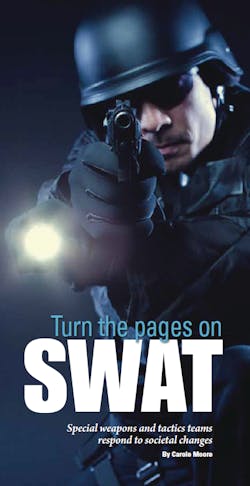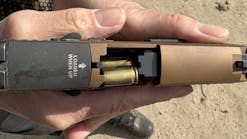On Aug. 1, 1966, a married 25-year-old former U.S. Marine and college student climbed to the observation deck of the campus tower at the University of Texas at Austin and opened fire on the crowd below.
Charles Whitman, a clean-cut blond engineering major, had already murdered both his mother and young wife prior to climbing that tower. As he ascended to the structure’s 28th floor, Whitman killed another three people and wounded two more. After establishing a vantage point, the heavily armed student systematically fired on anyone unfortunate enough to wander across his line of sight.
Police responding to the scene were unprepared for what they found; the situation was outside the scope of their training and experience. Finally, two officers reached the observation deck and took out Whitman. When the dust cleared, 15 others, including a police officer, had died. One pregnant woman also lost her unborn child. That incident was a seminal moment in the development of Special Weapons and Tactics. With the pull of a trigger, police across the country realized they needed to be better prepared for shooter and barricaded suspect scenarios.
But before Whitman came Watts
Frank Borelli, editor in chief of Law Enforcement Technology’s sister website, Officer.com, spent more than 30 years working in law enforcement, much of that time in the training of SWAT officers. Borelli says the Whitman shootings at the Texas tower, coupled with the influx of highly trained returning Vietnam veterans, set the stage for SWAT.
“Some people think Los Angeles had the first SWAT teams, but there was a little agency just north of there that had the first one,” Borelli says. He also points to the Watts riots as a major catalyst for SWAT operations, especially in L.A.
One year before Whitman climbed that Texas tower, the West Coast wake-up call sounded when a California Highway Patrol Officer named Lee Minikus conducted a traffic stop that culminated in the arrest of an L.A. resident and two other members of the suspect’s family. As a crowd of onlookers grew unruly, back-up officers were dispatched. Rioting in the predominantly black Watts section of L.A. broke out on Aug. 11, 1965, and continued for six days.
Rioters looted and burned businesses until the National Guard was brought in to quell the uprising. In addition to $40 million in damages (more than $275 million in today’s dollars), 34 people lost their lives and hundreds more sustained injuries. LAPD, which responded to the riots along with other local law enforcement agencies, found their approach to handling large-scale scenes like the Watts riots was not only ineffectual, but also put both officers and innocent civilians in jeopardy. It was obvious something had to change.
Those changes would eventually evolve into today’s SWAT.
Less than a decade after Watts
In 1974, an obscure college student by the name of Patty Hearst was abducted by a group of domestic terrorists who called themselves the Symbionese Liberation Army, or SLA. Led by an escaped black convict, Donald DeFreeze (also known as Cinque), the SLA consisted mostly of radical white men and women from upper middle class families.
After attempting to extort the wealthy Hearst family of publishing fame, the SLA, along with their former prisoner, Patty (who later claimed she suffered from Stockholm syndrome), divided, with six members of the group, including DeFreeze and four of the women, holing up in a home on 54th Street in Compton. Police tracked DeFreeze and the other five SLA members to the Compton address and sent the SWAT team in to bring them out. Ron McCarthy, who was the supervisor of one of the four LAPD SWAT units and participated in the SLA operations, says that at the time, “It was the biggest gunfight in law enforcement history.”
SWAT members said they saw the SLA moving furniture and appliances inside the home to block access points, indicating the occupants were preparing for a siege. Gunfire broke out after no less than eighteen warnings to put down their weapons and come out. The SWAT team was outgunned from the beginning: The SLA deployed fully automatic weapons capable of firing 1100 rounds per minute, along with a commercial Browning automatic rifle. Within minutes, many of the LAPD’s response team members ran out of ammunition.
SWAT officers requested grenades and were given the go-ahead, but seconds later that permission was reversed. Police continued to pelt the house with tear gas. Eventually, the house caught fire. The SLA shooters lowered themselves into the crawlspace under the house, where they continued firing on police.
Two of the women broke into the clear, shooting as they ran. Both died in the gun battle. The other four also perished – two of smoke inhalation – before the siege was over. Witnesses say they believe the six intended for the stand to be their last. When the fire was out, the bodies recovered and the scene processed, investigators came to a remarkable conclusion: Police had expended a total of more than 5,000 rounds, while the SLA spent almost 4,000 rounds. The incident set a precedent for gunfire violence, yet other than the suspects, no one else was hit. Although still evolving, SWAT teams were already proving their worth
Early training and lessons from Columbine
According to McCarthy, now retired and working for police gear manufacturer Safariland, the LAPD SWAT team owes much of its early success to the foresight of the former police chief, Darryl Gates. As a young LAPD inspector, Gates saw plenty of promise in the department’s early efforts to build an elite team of officers capable of handling situations that required both superior weaponry and training.
Candidates culled from those recently returned from the jungle battles of Vietnam trained at Camp Pendleton alongside active duty armed forces. “It expanded not only in the United States, but all over the world; they have SWAT teams in Russia, they have SWAT teams everywhere. Basic tactics have been altered over time to the culture of crimes being committed now,” says McCarthy.
McCarthy says that while technology and equipment developed specifically for SWAT operations has improved, the equipment is only as good as the officers that use it. “It has to be operated by well-trained cops, in my opinion. That hasn’t changed,” he says.
One of the most defining incidents in SWAT history took place on April 20, 1999, at Columbine High School in the unincorporated area of Columbine, Colorado. The assault by two students on the school, which resulted in the deaths of 12 students and one teacher with another 24 injured, forever altered the approach of law enforcement agencies to similar incidents. Prior to Columbine, responding officers formed and maintained a perimeter to contain the damage; removing the threat came secondary. Law enforcement was strongly criticized for this approach, particularly since the two Columbine shooters continued their rampage with law enforcement surrounding the school. Police now use immediate action rapid deployment tactics, which places neutralization of the shooter as the primary objective.
“Cops can’t sit around on the perimeter in these kinds of events. They have to be aggressive, they have to be willing to run into the building and face the bullets,” says Officer.com’s Borelli.
SWAT hasn’t changed its primary focus, but it has learned to roll with the punches. Active shooters, hostage-taking and other high-risk situations are still the primary purview of SWAT teams, but police in general have had to rethink their overall responses to situations like Columbine or the more recent Mumbai attacks, and adjust their approaches.
Lessons from half a world away
On Nov. 26, 2008, terrorists launched coordinated attacks on 10 Mumbai-based targets. It took Indian authorities four days to bring all the situations under control. When it was over 164 people had died and more than 300 had suffered injuries. One terrorist was captured alive.
What made Mumbai such a pivotal event in SWAT training and preparations were the multiple points of attack. Mumbai not only reinforced the lessons from Columbine, but prompted organizations like the National Tactical Officers Association (NTOA) to revamp their training. Among the approaches adopted by NTOA is MACTAC (Multi-Assault Counter-Terrorism Action Capabilities).
John Gnagey, NTOA’s executive director and a seasoned SWAT officer, says that although SWAT is still reactive in nature, it’s evolved into a thinking man’s game. Gone are the days of relying on brute force to make an entry, says Gnagey. “The philosophy has changed; there are multiple ways of doing things. You have to think about it and do risk assessments. That’s an ongoing thing. And the minute you put that plan into operation, things will change,” he says.
Gnagey says flexibility is key for today’s SWAT teams. “You have to be able to think and not just be rote...because that’s the way you were taught to do it.”
Terrorism, technology and sophisticated weaponry have changed modern law enforcement and the way it approaches policing. The success of SWAT operations hinges on how adaptive teams and their departments are.
“We like to tell trainers and commanders that it’s like a three-dimensional chess board. You have to be at least three moves ahead of the individuals you’re operating against,” he says.
SWAT of the future
Gnagey is well positioned to see both where SWAT has been and where it’s going. He says SWAT planning involves not simply examining the types of call-outs a team receives, but also an assessment of the surrounding infrastructure.
“What is in my community that could be of viable interest to either a home-grown domestic terrorist or an international terrorist? Of course you look at New York and Dallas and big places like that, but you also have to look at your own city. It may be 65,000 people but it may be of major interest to some organization,” he says.
Gnagey endorses force multipliers like regional multijurisdictional teams, which, he says, are a good idea even if the agency has an excellent team. In an age when terrorists are able to launch Mumbai-type attacks, no team should remain standalone.
He also says more progressive teams are telling manufacturers what equipment they need to do their jobs. Instead of letting the supplier call the shots, SWAT should work with companies that will accommodate the team’s needs. One example he offers of technology being developed specifically for SWAT’s use is radar that allows police to see through walls. “They said ‘We need something different from what the power companies and fire departments use,’” says Gnagey.
But, he cautions, there are still many issues confronting future SWAT commanders and the departments that sponsor them. Chief among those are budgetary challenges, which threaten to derail some teams. Gnagey says he does not foresee SWAT’s extinction, especially with the constant threat of terrorism, but believes many teams may find themselves with other duties between call-outs. Versatility could be one of the saviors of SWAT, along with territorial flexibility, especially where midsize and smaller departments are concerned.
“Departments will sit down and say, ‘Maybe we can’t do this ourselves, but we can do this together,’” he says.
As for predictions of where SWAT will be in the next decade, Borelli, McCarthy and Gnagey concur: Events in other parts of the world, such as the recent economically-inspired riots in the United Kingdom, will ignite similar situations on U.S. shores. They say SWAT needs to be ready.
“We need to watch and take notes,” says Gnagey. “All law enforcement is going to have to do a significant revision to include what’s happening today in order to be ready for tomorrow.”

Carole Moore
A 12-year veteran of police work, Carole Moore has served in patrol, forensics, crime prevention and criminal investigations, and has extensive training in many law enforcement disciplines. She welcomes comments at [email protected].
She is the author of The Last Place You'd Look: True Stories of Missing Persons and the People Who Search for Them (Rowman & Littlefield, Spring 2011)
Carole can be contacted through the following:
- www.carolemoore.com
- Amazon author page: http://www.amazon.com/-/e/B004APO40S



